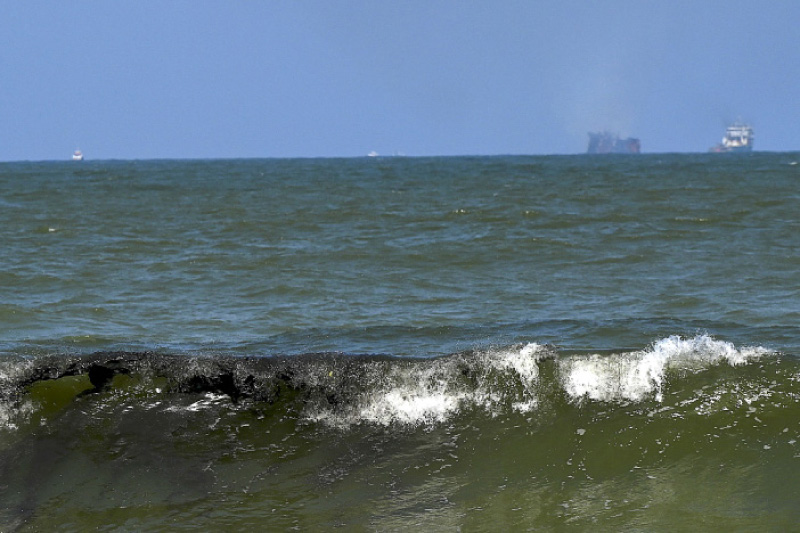Thursday Apr 03, 2025
Thursday Apr 03, 2025
Friday, 4 June 2021 03:45 - - {{hitsCtrl.values.hits}}

Oil floats near the beach of Sarakkuwa, just north of the capital Colombo on 2 June as the MV X-Press Pearl vessel, carrying hundreds of tons of chemicals and plastics, started to sink after burning for almost two weeks – AFP
AFP: Rough seas and poor visibility forced Sri Lanka navy divers to abandon an inspection on Thursday of a sinking ship threatening a disastrous oil spill off Colombo’s main harbour, officials said. A team of frogmen reached the stricken MV X-Press Pearl and made a cursory inspection, but could not carry out their mission to examine the hull, navy officials said.
Dutch salvage company SMIT, which directed the navy team, said the underwater inspection had to be called off due to weather issues.
“Navy divers attempted to inspect the vessel under the direction of salvors but were forced to resurface due to poor visibility,” operators of the ship, X-Press Feeders said in a statement.
However, the Marine Environment Protection Authority (MEPA) readied oil dispersants and skimmers in case of a leak from the Singapore-registered vessel which had 350 tons of fuel oil on board when it caught fire two weeks ago.
The vessel, which burned for 13 days until Tuesday, has already caused the island’s worst maritime environmental disaster, littering beaches with tons of tiny plastic pellets.
With the stern now on the seabed and the bow slowly sinking, environmentalists fear an oil leak would cause even greater degradation to marine life.
An Indian coastguard vessel in the area has equipment to deal with any oil slick, according to the Sri Lankan navy, which requested assistance with the operation.
Sri Lanka’s Harbour Master Nirmal Silva confirmed there was no oil leak since the vessel submerged.
“Looking at the way the ship burnt, expert opinion is that bunker oil may have burnt out, but we are preparing for the worst-case scenario,” Silva said.
Two-metre (six feet) waves, rain and strong winds prevented salvage experts from going on board to assess whether the ship could be re-floated and moved further out to sea, he added. Alternatively, it could be broken apart in the relatively shallow water.
Sri Lanka’s private Centre for Environmental Justice (CEJ) fears the disaster may also cause heavy metal pollution.
The vessel was carrying 81 containers of “dangerous cargo” including acids and lead ingots.
“There is a chemical soup in that sea area,” CEJ Executive Director Hemantha Withanage told AFP.
“The damage to the marine ecosystem is incalculable.”
However, he said the silver lining was that there was no sign of an oil spill yet. Some oil was spotted near the beaches of Negombo, about 40 kilometres from Colombo, but the cause was not clear.
The escape of micro-plastic granules from the ship’s cargo has already forced a fishing ban and prompted concern for the marine environment as well as the local economy.
“The ban is affecting 4,300 families in my village,” said Denzil Fernando, Head of the Sea Street Fishermen’s Association in Negombo.
“Most people live on one meal a day; how long can we go on like this?” Fernando told AFP.
“Either the Government must allow us to fish or give us compensation.”
Authorities believe the fire was caused by a nitric acid leak which the crew apparently knew about nine days before the blaze started.
Police said three officers from the ship – two Russians and an Indian – had been questioned and their passports impounded.
The ship was heading to Colombo from India. Its 25 crew were evacuated last week. Two suffered minor injuries.

Discover Kapruka, the leading online shopping platform in Sri Lanka, where you can conveniently send Gifts and Flowers to your loved ones for any event including Valentine ’s Day. Explore a wide range of popular Shopping Categories on Kapruka, including Toys, Groceries, Electronics, Birthday Cakes, Fruits, Chocolates, Flower Bouquets, Clothing, Watches, Lingerie, Gift Sets and Jewellery. Also if you’re interested in selling with Kapruka, Partner Central by Kapruka is the best solution to start with. Moreover, through Kapruka Global Shop, you can also enjoy the convenience of purchasing products from renowned platforms like Amazon and eBay and have them delivered to Sri Lanka.
Discover Kapruka, the leading online shopping platform in Sri Lanka, where you can conveniently send Gifts and Flowers to your loved ones for any event including Valentine ’s Day. Explore a wide range of popular Shopping Categories on Kapruka, including Toys, Groceries, Electronics, Birthday Cakes, Fruits, Chocolates, Flower Bouquets, Clothing, Watches, Lingerie, Gift Sets and Jewellery. Also if you’re interested in selling with Kapruka, Partner Central by Kapruka is the best solution to start with. Moreover, through Kapruka Global Shop, you can also enjoy the convenience of purchasing products from renowned platforms like Amazon and eBay and have them delivered to Sri Lanka.